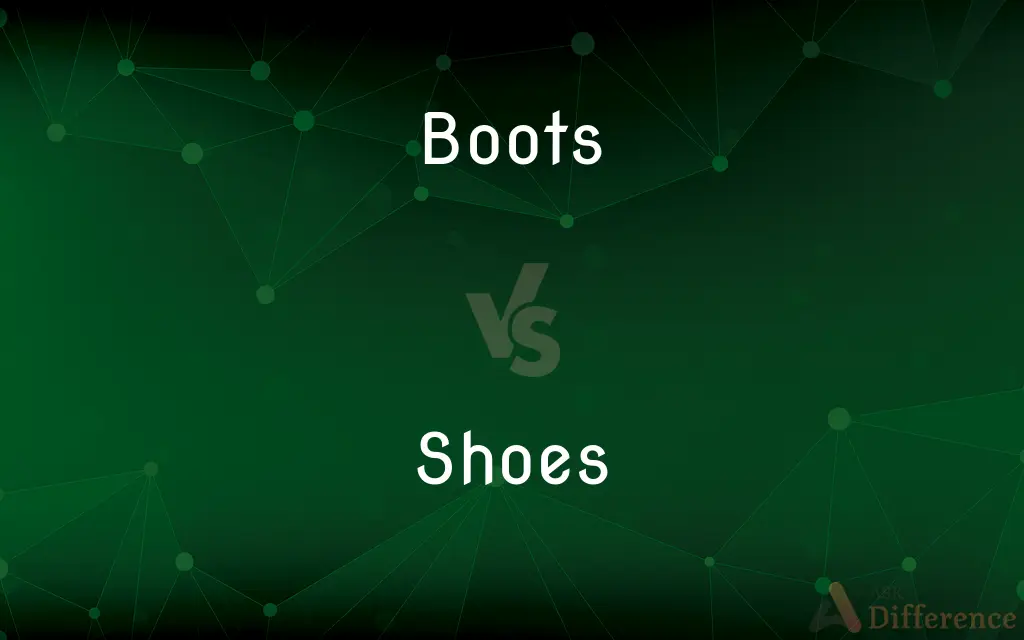Boots vs. Shoes — What's the Difference?
By Tayyaba Rehman — Updated on September 23, 2023
Boots typically cover the foot and part of the leg, while shoes only cover the foot.

Difference Between Boots and Shoes
Table of Contents
ADVERTISEMENT
Key Differences
Boots are a type of footwear designed not just to cover the foot but also to extend upwards, covering a portion of the leg. This design provides additional support and protection to the ankle and, in some cases, the calf, knee, or even the thigh. Shoes, on the other hand, are created to wrap around the foot, offering protection and comfort without extending beyond the ankle.
The utility of boots often lends itself to specific purposes or environments. For instance, snow boots are crafted to handle cold conditions, and work boots are constructed robustly for safety in industrial settings. Shoes, in contrast, are more versatile in their application and are available in various styles suitable for casual, formal, athletic, or specific activities.
Additionally, due to their extended coverage, boots are often perceived as warmer than shoes, making them ideal for colder climates. Shoes, with their design restricted to the foot, allow for more breathability, making them preferable in warmer conditions.
Lastly, from a fashion perspective, boots can be a statement piece, reflecting ruggedness, style, or elegance, depending on their design. Shoes, with their vast range of styles from heels to flats, sneakers to loafers, cater to diverse fashion statements, occasions, and personal preferences.
Comparison Chart
Coverage
Cover the foot and part of the leg.
Cover only the foot.
ADVERTISEMENT
Utility
Often specific to environments or tasks.
More versatile for various activities.
Temperature Suitability
Generally warmer due to extended coverage.
Typically cooler and more breathable.
Types
Work boots, snow boots, cowboy boots, etc.
Sneakers, loafers, heels, sandals, etc.
Ankle Support
Provide more ankle support because of their design.
Typically provide less ankle support.
Compare with Definitions
Boots
Footwear extending above the ankle.
The hiker wore sturdy boots to navigate the rough terrain.
Shoes
Footwear covering the foot below the ankle.
He bought new running shoes for the marathon.
Boots
Footwear providing warmth.
She wore fur-lined boots in the snowy weather.
Shoes
Items worn to protect or comfort the feet.
She had a pair of shoes for every occasion.
Boots
Protective or specialized footwear.
The construction worker had steel-toed boots for safety.
Shoes
Footwear designed for specific activities.
Golf shoes provide better grip on the green.
Boots
Fashionable footwear covering part of the leg.
Leather boots are popular during the fall season.
Shoes
Everyday wear for walking or running.
Comfortable shoes are essential for long journeys.
Boots
A durable covering for the foot and part or much of the leg, usually made of leather, fabric, plastic, or rubber.
Shoes
Fashion accessories complementing an outfit.
Her red shoes perfectly matched her dress.
Boots
A protective covering, especially a sheath to enclose the base of a floor-mounted gear shift lever in a car or truck.
Shoes
A durable covering for the human foot, made of leather or similar material with a rigid sole and heel, usually extending no higher than the ankle.
Boots
Chiefly British An automobile trunk.
Shoes
A horseshoe.
Boots
A kick.
Shoes
A strip of metal fitted onto the bottom of a sled runner.
Boots
(Slang) An unceremonious dismissal, as from a job. Used with the.
Shoes
The base for the supports of the superstructure of a bridge.
Boots
(Slang) A swift, pleasurable feeling; a thrill.
Shoes
The ferrule on the end of a cane.
Boots
A Denver boot.
Shoes
The casing of a pneumatic tire.
Boots
A marine or navy recruit in basic training.
Shoes
A device that retards or stops the motion of an object, as the part of a brake that presses against the wheel or drum.
Boots
(Computers) The process of starting or restarting a computer.
Shoes
The sliding contact plate on an electric train or streetcar that conducts electricity from the third rail.
Boots
Boots An instrument of torture, used to crush the foot and leg.
Shoes
A chute, as for conveying grain from a hopper.
Boots
Chiefly Southern & Midland US See lagniappe.
Shoes
(Games) A case from which playing cards are dealt one at a time.
Boots
(Archaic) Advantage; avail.
Shoes
Position; status
You would understand my decision if you put yourself in my shoes.
Boots
To put boots on.
Shoes
Plight
I wouldn't want to be in her shoes.
Boots
To kick
Booted the ball into the goal.
Shoes
To furnish or fit with a shoe or shoes.
Boots
(Slang) To discharge unceremoniously.
Shoes
To cover with a wooden or metal guard to protect against wear.
Boots
(Computers) To start (a computer) by loading an operating system from a disk.
Shoes
Plural of shoe
Boots
To disable (a vehicle) by attaching a Denver boot.
Shoes
A particular situation;
If you were in my place what would you do?
Boots
(Baseball) To misplay (a ground ball).
Boots
To be of help or advantage; avail.
Boots
Plural of boot
Boots
A condom.
Boots
(dated) A servant at a hotel etc. who cleans and blacks the boots and shoes.
Boots
The ship in a fleet having the most junior captain.
Boots
A servant at a hotel or elsewhere, who cleans and blacks the boots and shoes.
Boots
Durable footwear for rugged conditions.
Military personnel often wear tactical boots in the field.
Common Curiosities
Are shoes generally lighter than boots?
Yes, shoes are typically lighter than boots since they cover less area.
Are athletic sneakers considered shoes or boots?
Athletic sneakers are considered shoes.
Why might someone choose boots over shoes?
Someone might choose boots for additional support, protection, warmth, or fashion reasons.
Do boots offer more ankle support than shoes?
Yes, boots generally provide more ankle support due to their design.
Is it common for work industries to require boots?
Yes, many work industries prefer boots for safety and support.
Can boots be worn in all seasons?
While boots are popular in colder seasons, there are boots designed for various climates and purposes.
Which is typically more expensive, boots or shoes?
Boots are often more expensive due to more materials used, but prices can vary based on brand and quality.
Why are boots popular in winter?
Boots provide warmth and protection against cold and wet conditions.
Are sandals and flip-flops classified as shoes?
Yes, sandals and flip-flops are types of shoes.
Are there formal types of boots?
Yes, there are formal boots, such as dress boots, designed for elegant occasions.
Do all boots extend above the knee?
No, boots vary in length, with some just above the ankle and others extending above the knee.
Can shoes offer the same protection as boots in rough conditions?
Generally, boots provide more protection due to their design, but specific shoes can be designed for protection.
Which is more breathable, shoes or boots?
Shoes are typically more breathable due to their design covering only the foot.
Do shoes offer more variety in design than boots?
Shoes often have a broader range of styles, but both categories offer diverse designs.
Can both boots and shoes be made of leather?
Yes, both boots and shoes can be crafted from leather.
Share Your Discovery

Previous Comparison
Claim vs. Argument
Next Comparison
Lutheran vs. ChristianAuthor Spotlight
Written by
Tayyaba RehmanTayyaba Rehman is a distinguished writer, currently serving as a primary contributor to askdifference.com. As a researcher in semantics and etymology, Tayyaba's passion for the complexity of languages and their distinctions has found a perfect home on the platform. Tayyaba delves into the intricacies of language, distinguishing between commonly confused words and phrases, thereby providing clarity for readers worldwide.














































